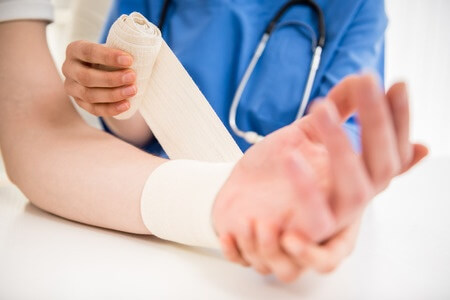
Cuts and puncture wounds are an occupational hazard for children and are even hard to avoid among adults. With a minimum of care, most cuts and scrapes heal after a few days, but anytime you tear or puncture the skin, you should be on the lookout for signs that you need further medical attention This is especially true with puncture wounds, which can introduce infection below the skin.
Treating A Simple Cut
When you cut or scrape your skin, you may slice or wear away the top layer of skin cells. The resulting cut or abrasion may be painful, dirty, and bleeding. By cleaning the wound and keeping it clean and dry, you should see healing in a few days. However, to prevent infection or other problems, you should take the following steps:
- Wash the injury with soap and water rather than with peroxide or iodine, which can delay healing.
- Apply an antibiotic ointment such as Neosporin and keep the wound covered with a bandage.
- Change the bandage if it gets wet or dirty.
- Seek medical attention if the wound does not stop bleeding within six hours, as you might need stitches.
- Also see a doctor if the wound is red, swollen, extremely painful, provokes a fever, or has pus draining from it.
- If the cut is near your eye, obtain medical treatment at once.
Special Concerns For Puncture Wounds
If you have stepped on a nail or sustained another puncture wound, you run the extra risk of infection. You should immediately seek medical attention if the puncture wound spurts blood, does not stop bleeding, or produces severe pain, trouble breathing, fast breathing, vomiting, dizziness, or unconsciousness.
Since puncture wounds pierce the skin, you do not know if there is internal damage that resulted. You should seek immediate medical attention if:
- The wound is on your face, chest, abdomen, or neck
- The wound appears dirty
- The wound is deep or you can feel the object touching bone
- You cannot easily remove the item that caused the puncture
- The wound is from an animal or human bite
- You stepped on a nail that pierced your shoe
If the puncture wound appears minor, approach it like any other cut or scrape: clean it with soap and water, apply and antibiotic cream and apply a bandage. If you have pain, take ibuprofen or acetaminophen. Check with your doctor about possibly getting a tetanus shot if you have not had one in the past 5 to 10 years.
When To Seek Medical Attention
Treating minor cuts and puncture wounds is a safe and manageable job for home-based first-aid. However, you should seek emergency treatment if it appears serious or it won’t stop bleeding. Deeper, more invasive cuts often need stitches, while puncture wounds might require special attention to prevent infection.
No matter what kind of wound you have, make sure to watch for signs of infection, which can include yellow or green pus around the wound or redness, swelling, or increased pain. Any of these would warrant seeing your doctor.
If you are concerned about a cut or puncture wound, make an appointment at Raintree Medical & Chiropractic Center to evaluate the wound and provide necessary treatment.

